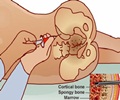Researchers at Universiti de Montrial have successfully produced a large quantity of laboratory stem cells from a small number of blood stem cells obtained from bone marrow.
The research team, led by Dr. Guy Sauvageau, has taken a giant step towards the development of a revolutionary treatment based on these stem cells.It is known that a bone marrow stem cell transplant can reconstitute the recipient's bone marrow. The main difficulty is to obtain a sufficient number of compatible stem cells.
But these patients will be able to obtain new bone marrow within the next few years, thanks to Sauvageau and his team.
"It could be possible to envision transplants for all adults from existing umbilical cord blood banks. The stem cell content of these blood banks is currently too limited for large-scale use in adults," Sauvageau said.
Presently, transplant recipients are condemned to take medications against rejection of the transplanted organ and suffer the side effects for the rest of their lives.
However, "mouse studies exist, showing that bone marrow stem cells can prevent the rejection typically directed against solid organs," Sauvageau said.
Advertisement
By extrapolation from laboratory studies, it is very likely that transplanting hematopoietic stem cells collected from the organ donor and developed in the laboratory could avoid rejection of this organ.
Advertisement
To produce large quantities of hematopoietic stem cells in the laboratory, the researchers identified 10 proteins out of 700 candidates.
These 10 proteins are naturally present in hematopoietic stem cells and researchers can use each of them to force these cells to multiply in the laboratory.
"The next step is to verify whether this also works in humans. Everything is already in place," Sauvageau said.
The findings are being published in the prestigious scientific journal Cell.
Source-ANI
SRM














